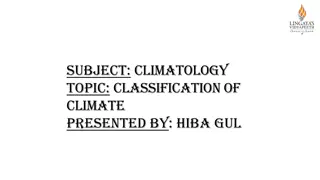Understanding Tropical Cyclones and Layers of the Atmosphere
Tropical cyclones are warm-core low-pressure systems that form over oceans with high sea surface temperatures. The Philippines is prone to these cyclones, leading to heavy rains, flooding, and strong winds. The layers of the atmosphere, from the exosphere to the troposphere, play crucial roles in shaping weather patterns and phenomena like tropical cyclones. Learn about tropical cyclone formation requirements and the characteristics of different atmospheric layers.
Download Presentation

Please find below an Image/Link to download the presentation.
The content on the website is provided AS IS for your information and personal use only. It may not be sold, licensed, or shared on other websites without obtaining consent from the author. Download presentation by click this link. If you encounter any issues during the download, it is possible that the publisher has removed the file from their server.
E N D
Presentation Transcript
SCIENCE: TROPICAL CYCLONE Q2: OCT 19 WEEK
LAYERS OF ATMOSPHERE Exosphere. Upper limit of the atmosphere. Extends from thermosphere up to 10,000 km (6,200 mi) Ionosphere. Abundant layer of electrons and ionized atoms and molecules that stretches from about 48 kilometers (30 miles) above the surface to the edge of space at about 965 km (600 mi), overlapping into the mesosphere and thermosphere. Critical link in the chain of Sun-Earth interactions. Region that makes radio communications possible. Thermosphere. Above the mesosphere and extends to 600 kilometers (372 miles) high. Aurora and satellites occur in this layer. Mesosphere: Above the stratosphere and extends to 85 kilometers (53 miles) high. Meteors burn up in this layer Stratosphere: Starts just above the troposphere and extends to 50 kilometers (31 miles) high. The ozone layer, which absorbs and scatters the solar ultraviolet radiation, is in this layer. Troposphere: Starts at the Earth's surface and extends 8 to 14.5 kilometers high (5 to 9 miles) Most dense part of the atmosphere Almost all weather is in this region https://search.yahoo.com/search?fr=mcafee&type=E211US1400G0&p=layers+of+atmosphere
TROPICAL CYCLONES: DEFINITION Warm-core low pressure systems associated with a spiral inflow of mass at the bottom level and spiral outflow at the top level. Form over oceans where sea surface temperature, also air temperatures are greater than 26 C. (WHERE) Non-frontal, synoptic-scale cyclone developing over tropical and sub-tropical waters at any level and having a definitely organized circulation. (WHERE, CHARACTERISTICS) The air accumulates large amounts of sensible and latent heat as it spirals towards the center. It receives this heat from the sea and the exchange can occur rapidly, because of the large amount of spray thrown into the air by the wind. (HOW) The energy of the tropical cyclone is thus derived from the massive liberation of the latent heat of condensation. (HOW) http://bagong.pagasa.dost.gov.ph/information/about-tropical-cyclone#tropical-cyclone-mobile
TROPICAL CYCLONES The Philippines is prone to tropical cyclones due to its geographical location which generally produce heavy rains and flooding of large areas and also strong winds which result in heavy casualties to human life and destructions to crops and properties. http://bagong.pagasa.dost.gov.ph/information/about-tropical-cyclone#tropical-cyclone-mobile
TROPICAL CYCLONE: FORMATION REQUIREMENTS Large ocean areas with a surface temperature of more than 26 C or 27 C Initial disturbances may be detected within 5 of latitude of the equator, but these disturbances do not intensify into typhoons or hurricanes until they are more than 5 of latitude from the equator Weak vertical wind shear A pre-existing low level disturbance over a warm ocean area and a region of upper-level divergence or outflow above the surface disturbance Convective theory , a large mass of air becomes convectively unstable and moist compared with its surroundings, which results in an upward motion of air. The air from the surroundings tend toward the low pressure area formed, so that, a cyclonic circulation is formed. The combined effects of the earth's rotation and the centrifugal force, retards the movements of air towards the center causing further pressure fall. The process continues until a vigorous cyclonic wind system is developed. Likewise, the outward flow of air from the center at high levels also makes the pressure lower. http://bagong.pagasa.dost.gov.ph/information/about-tropical-cyclone#tropical-cyclone-mobile
TROPICAL CYCLONE: CLASSIFICATION Degree of intensity: Tropical cyclone with maximum sustained winds of up to 61 kilometers per hour (kph) or less than 33 nautical miles per hour (knots) . Tropical cyclone with maximum wind speed of 62 to 88 kph or 34 - 47 knots. Tropical cyclone with maximum wind speed of 89 to 117 kph or 48 - 63 knots. Tropical cyclone with maximum wind speed of 118 to 220 kph or 64 - 120 knots. Tropical cyclone with maximum wind speed exceeding 220 kph or more than 120 knots. SEVERE TROPICAL STORM (STS) TROPICAL DEPRESSION (TD) TROPICAL STORM (TS) TYPHOON SUPER TYPHOON (STY) Classification of tropical cyclones according to the strength of the associated wind as adopted by PAGASA as of 01 May 2015 http://bagong.pagasa.dost.gov.ph/information/about-tropical-cyclone#tropical-cyclone-mobile
THE ROLE OF PAG-ASA PAGASA: Philippine Atmospheric, Geophysical and Astronomical Services Administration One of the attached agencies of the Department of Science and Technology (DOST) under its Scientific and Technical Services Institute Mandated to provide protection against natural calamities and utilize scientific knowledge as an effective instrument to ensure the safety, well being and economic security of all the people, and for the promotion of national progress.























